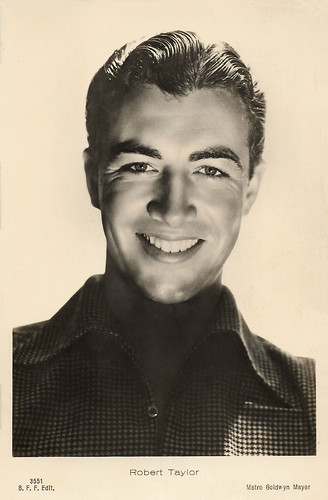
Italian postcard by B.F.F. (Ballerini & Fratini, Firenze) Edit., no. 3551. Photo: George Hurrell / Metro Goldwyn Mayer (MGM).

British postcard, no. 146B. Sent by mail in 1937. Photo: Metro-Goldwyn-Mayer. Robert Taylor in Camille (George Cukor, 1936).
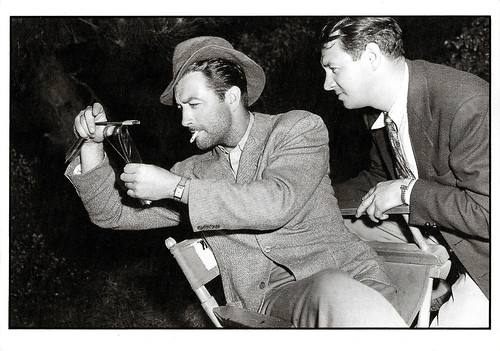
French postcard in the Entr'acte series by Éditions Asphodèle. Mâcon, no. 001/29 Photo: Robert Taylor and director of photography Harry Stradling at the set of Song of Russia (Gregory Ratoff, 1944) in 1943. Caption: Famous photographer Harry Stradling submitted some rushes of the film to Robert Taylor shortly before he was drafted into the US Navy.

French postcard, no. 492. Photo: Metro Goldwyn Mayer.
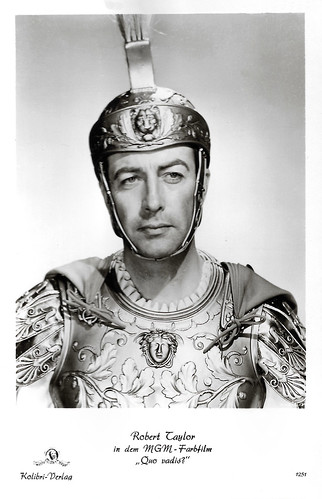
West-German postcard by Kolibri-Verlag, no. 1251. Photo: MGM. Photo: Metro-Goldwyn-Mayer. Robert Taylor in Quo Vadis? (Mervyn LeRoy, 1951).
The test boy
Robert Taylor was born Spangler Arlington Brugh in 1911, in Filley, Nebraska. Taylor was the only child of Ruth Adaline (née Stanhope) and Spangler Andrew Brugh, a farmer turned doctor. During his early life, the family moved several times, and by September 1917, the Brughs had moved to Beatrice, Nebraska, where they remained for 16 years.
As a teenager, Taylor was a track and field star and played the cello in his high school orchestra. Upon graduation, he enrolled at Doane College in Crete, Nebraska. While at Doane, he took cello lessons from Professor Herbert E. Gray, whom he admired and idolised. After Professor Gray announced he was accepting a new position at Pomona College in Claremont, California, Taylor moved to California and enrolled at Pomona.
He joined the campus theatre group and was eventually spotted by an MGM talent scout in 1932 after a production of 'Journey's End'. He signed a seven-year contract with Metro-Goldwyn-Mayer. The studio changed his name to Robert Taylor. He made his film debut on loan-out to Fox in the comedy Handy Andy (David Butler, 1934) starring Will Rogers.
His first leading role came by accident. In 1934 Taylor was on the MGM payroll as "the test boy," a male juvenile who would be filmed opposite various young ingenues in screen tests. In late 1934, when MGM began production of its new short-subject series Crime Does Not Pay with the dramatic short Buried Loot (George B. Seitz, 1935), the actor who had been cast fell ill and could not appear. The director sent for the test boy to substitute for the missing actor.
Taylor's dramatic performance, as an embezzler who deliberately disfigures himself to avoid detection, was so memorable that Taylor immediately was signed for feature films. In 1935, Irene Dunne requested him for her leading man in Magnificent Obsession (John M. Stahl, 1935), again on loan-out, this time to then struggling Universal Pictures. He played a happy-go-lucky party guy who inadvertently causes blindness to the young lady he wishes to impress and then becomes a doctor in order to cure her. The film was a big hit, and Taylor had a taste of instant box-office stardom.
Along with his good looks, Taylor already showed solid dramatic skill in Camille (George Cukor, 1936) with Greta Garbo. Throughout the late 1930s, Taylor appeared in films of varying genres including the musicals Broadway Melody of 1936 (Roy Del Ruth, 1935) and Broadway Melody of 1938 (Roy Del Ruth, 1937), and the British comedy A Yank at Oxford (Jack Conway, 1938) with Lionel Barrymore and Vivien Leigh.

German postcard by Ross Verlag, no. A 2283/1, 1939-1940. Photo: Universal Pictures. Robert Taylor in Magnificent Obsession (John M. Stahl, 1935).
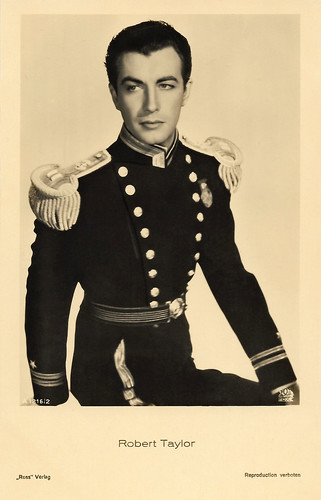
German postcard by Ross Verlag, no. A 1216/2, 1937-1938. Photo: 20th Century Fox. Robert Taylor in This Is My Affair (William A. Seiter, 1937).

German postcard by Ross Verlag, no. A 1330/1, 1937-1938, Photo: Metro-Goldwyn-Mayer. Greta Garbo and Robert Taylor in Camille (George Cukor, 1936).

German postcard by Ross Verlag, no. A 1499/1, 1937-1938. Photo: Quick.
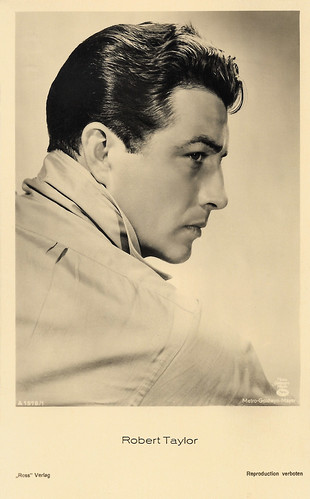
German postcard by Ross Verlag, no. A 1578/1, 1937-1938. Photo: Metro-Goldwyn-Mayer.

German postcard by Ross Verlag, no. A 2299/1, 1939-1940. Photo: Metro-Goldwyn-Mayer / Schostal.
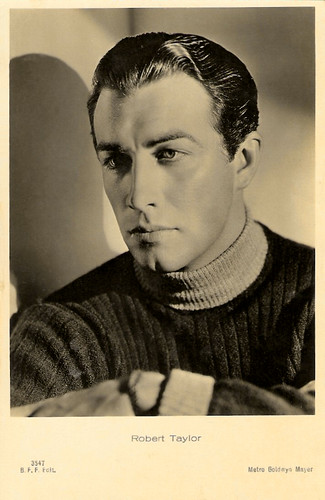
Italian postcard by B.F.F. Edit, no. 3547. Photo: Metro-Goldwyn-Mayer.
The Man with the Perfect Profile
Throughout 1940 and 1941 Robert Taylor argued in favour of American entry into World War II and was sharply critical of the isolationist movement. During this time he said he was "100% pro-British". In 1940, he reteamed with Vivien Leigh in Mervyn LeRoy's drama Waterloo Bridge, a personal favourite by both Leigh and Taylor.
After being given the nickname "The Man with the Perfect Profile", Taylor began breaking away from his perfect leading man image and began appearing in darker roles beginning in 1941. That year, he portrayed Billy Bonney (better known as Billy the Kid) in Billy the Kid (David Miller, 1941). The next year, he played the title role in the Film Noir Johnny Eager (Mervyn LeRoy, 1942) with Lana Turner.
After playing a tough sergeant in the World War II drama Bataan (Tay Garnett, 1943), Taylor contributed to the war effort by becoming a flying instructor in the U.S. Naval Air Corps. During this time, he also starred in instructional films and narrated the documentary The Fighting Lady (Edward Steichen, 1944).
After the war, he appeared in edgy roles in the Film Noirs Undercurrent (Vincente Minnelli, 1946) opposite Katharine Hepburn, and High Wall (Curtis Bernhardt, 1947). In 1949, he co-starred with Elizabeth Taylor in the Film Noir Conspirator (Victor Saville, 1949), which Hedda Hopper described as "another one of Taylor's pro-British films". Taylor responded to this by saying "And it won't be the last!"
However, both Hopper and Taylor were members of the anticommunist organisation the Motion Picture Alliance for the Preservation of American Ideals. Taylor landed the role of General Marcus Vinicius in Quo Vadis (Mervyn LeRoy, 1950) with Deborah Kerr. The epic film was a hit, grossing US$11 million in its first run.
The following year, he starred in the film version of Walter Scott's classic Ivanhoe (Richard Thorpe, 1951), again with Elizabeth Taylor. It was followed by two more historical adventure films, Knights of the Round Table (Richard Thorpe, 1953) and The Adventures of Quentin Durward (Richard Thorpe, 1955), all filmed in England. Of the three only Ivanhoe was a critical and financial success. Taylor also filmed Valley of the Kings (Robert Pirosh, 1954) in Egypt.
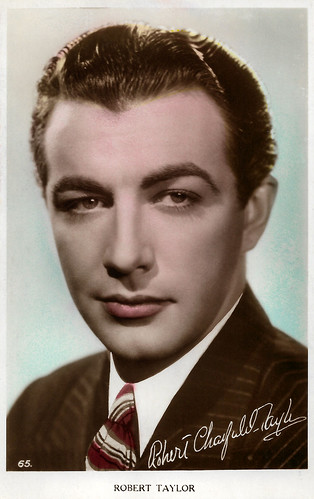
British Art Photo postcard, no. 65.

British Art Photo postcard, no. 126. Photo: Metro-Goldwyn-Mayer. Greta Garbo and Robert Taylor in Camille (George Cukor, 1936).

British postcard in the Film Partners Series, London, no. P 185. Photo: Metro-Goldwyn-Mayer. Robert Taylor and June Knight in Broadway Melody (Roy Del Ruth, 1936).

British postcard in the Film Partner Series, London, no. P. 186. Photo: Metro-Goldwyn-Mayer. Robert Taylor and Eleanor Powell in Broadway Melody of 1938 (Roy Del Ruth, 1937).

British Real Photograph postcard, London, no. FS 120. Photo: 20th Century Fox. Robert Taylor and Barbara Stanwyck in His Affair (William A. Seiter, 1937).

British postcard in the Film Partners Series, London, no. P 255, Photo: Metro-Goldwyn-Mayer. Maureen O'Sullivan and Robert Taylor in A Yank at Oxford (Jack Conway, 1938).

British postcard in the Picturegoer Series, London, no. 1393. Photo: Metro-Goldwyn-Mayer. Vivien Leigh and Robert Taylor in Waterloo Bridge (Mervyn LeRoy, 1940).
The quintessential MGM company man
By the mid-1950s, Robert Taylor began to concentrate on Westerns, his preferred genre. He starred in a comedy Western Many Rivers to Cross (Roy Rowland, 1955) co-starring Eleanor Parker. In 1958, he shared the lead with Richard Widmark in the edgy Western The Law and Jake Wade (John Sturges, 1958).
William McPeak at IMDb: "That he usually comes across on screen as having a confident, commanding presence is more of a testimony to his acting talent than his actual personality. He held rigid right-wing political beliefs that he refused to question and, when confronted with an opposing viewpoint, would simply reject it outright. He rarely, if ever, felt the need to be introspective. Taylor simply felt blessed to be working behind the walls of MGM. His affection for the studio would blind him to the fact that boss Louis B. Mayer masterfully manipulated him for nearly two decades, keeping Taylor's salary the lowest of any major Hollywood star. But this is also indicative of how much trust he placed in the hands of the studio's leaders. Indeed, Taylor remained the quintessential MGM company man and would be rewarded by remaining employed there until the demise of the studio system in the late 1950s."
In 1958, he left MGM and formed Robert Taylor Productions, and the following year, he starred in the television series The Detectives Starring Robert Taylor (1959–1962). Following the end of the series in 1962, Taylor continued to appear in films and television shows, including A House Is Not a Home and two episodes of Hondo.
In 1963, NBC filmed but never aired, four episodes of what was to have been The Robert Taylor Show, a series based on case files from the United States Department of Health, Education and Welfare. The project was suddenly dropped for lack of coordination with HEW. In the same year, he filmed Miracle of the White Stallions for Walt Disney Productions.
In 1964, Taylor co-starred with his former wife Barbara Stanwyck in William Castle's psychological horror film The Night Walker. Taylor traveled to Europe to film the Western Savage Pampas (Hugo Fregonese, 1966), the adventure film The Glass Sphinx (Luigi Scattini, 1967), and the comedy spy-thriller The Day the Hot Line Got Hot (Etienne Périer, 1968) with Charles Boyer.
In 1965, Taylor took over the role of narrator in the television series Death Valley Days when Ronald Reagan left to pursue a career in politics. Taylor would remain with the series until his death in 1969.
Taylor married Barbara Stanwyck in 1939 and they divorced in 1951. Taylor met German actress Ursula Thiess in 1952. They married in 1954. The couple had two children, a son, Terrance (1955), and a daughter, Tessa (1959). Taylor was stepfather to Thiess' two children from her previous marriage, Manuela and Michael Thiess. On 26 May 1969, shortly before Taylor's death at only 57 from lung cancer, Ursula Thiess found the body of her son, Michael, in a West Los Angeles motel room. He died from a drug overdose. One month before his death, Michael had been released from a mental hospital. In 1964, he spent a year in a reformatory for attempting to poison his father with insecticide.

Belgian collectors card by Kwatta, no. C. 248. Photo: MGM. Publicity still for Ambush (Sam Wood, 1950).

Belgian postcard, no. 618. Photo: M.G.M. Elizabeth Taylor and Robert Taylor.

French postcard by Editions P.I., Paris, no. 503, 1954. Photo: Metro-Goldwyn-Mayer. Robert Taylor in Ambush (Sam Wood, 1950).

West-German postcard by Kolibri-Verlag, Minden/Westf., no. 1252. Photo: Metro-Goldwyn-Mayer. Robert Taylor in Quo Vadis? (Mervyn LeRoy, 1951).

French postcard by Editions P.I., Paris, no. 25 G. Photo: Metro-Goldwyn-Mayer. Robert Taylor in Quo Vadis? (Mervyn LeRoy, 1951).
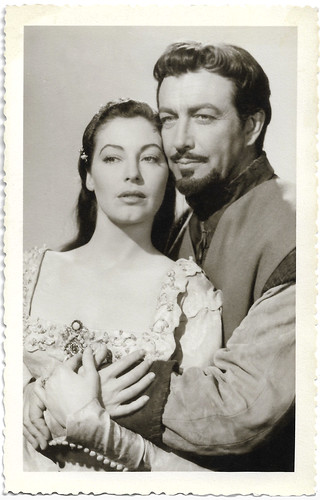
Spanish postcard by Celuloide Stars. Robert Taylor and Ava Gardner in Knights of the Round Table (Richard Thorpe, 1953).

German postcard by Kolibri-Verlag G.m.b.H., Minden/Westf, no. 2819. Photo: Metro-Goldwyn-Mayer. Elisabeth Müller and Robert Taylor in The Power and the Prize (Henry Koster, 1956).

West-German postcard by Ufa/Film-Foto. Photo: MGM.

German postcard by Kunst und Film Verlag H. Lukow, Hannover, no. L2/1042. Caption: Filmschauspieler aus aller Welt (Film actors from around the world).
From top left to down right: Linda Darnell, Tyrone Power, Elizabeth Taylor, Robert Taylor and his wife Ursula Thiess, Gina Lollobrigida and her husband Milko Skofic, Audrey Hepburn and Mel Ferrer, Mona Baptiste, Mara Lane, and Gloria de Haven.
Sources: William McPeak (IMDb), Wikipedia, and IMDb.
No comments:
Post a Comment